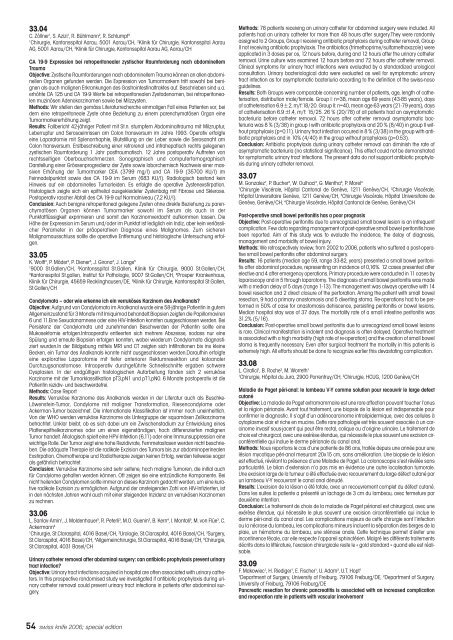Abstracts 4. Gemeinsamer Jahreskongress der ... - SWISS KNIFE
Abstracts 4. Gemeinsamer Jahreskongress der ... - SWISS KNIFE
Abstracts 4. Gemeinsamer Jahreskongress der ... - SWISS KNIFE
Create successful ePaper yourself
Turn your PDF publications into a flip-book with our unique Google optimized e-Paper software.
swissknife spezial 06 12.06.2006 13:39 Uhr Seite 54<br />
33.04<br />
C. Zöllner 1 , S. Azizi 1 , R. Bühlmann 2 , R. Schlumpf 3<br />
1 Chirurgie, Kantonsspital Aarau, 5001 Aarau/CH, 2 Klinik für Chirurgie, Kantonsspital Aarau<br />
AG, 5001 Aarau/CH, 3 Klinik für Chirurgie, Kantonsspital Aarau AG, Aarau/CH<br />
CA 19-9 Expression bei retroperitonealer zystischer Raumfor<strong>der</strong>ung nach abdominellem<br />
Trauma<br />
Objective: Zystische Raumfor<strong>der</strong>ungen nach abdominellem Trauma können an allen abdominellen<br />
Organen gefunden werden. Die Expression von Tumormarkern tritt sowohl bei benignen<br />
als auch malignen Erkrankungen des Gastrointestinaltraktes auf. Beschrieben sind u.a.<br />
erhöhte CA 125 und CA 19-9 Werte bei retroperitonealen Zystadenomen, bei retroperitonealen<br />
muzinösen Adenokarzinomen sowie bei Milzzysten.<br />
Methods: Wir stellen den gemäss Literaturrecherche einmaligen Fall eines Patienten vor, bei<br />
dem eine retroperitoneale Zyste ohne Beziehung zu einem parenchymatösen Organ eine<br />
Tumormarkererhöhung zeigt.<br />
Results: Fallbericht 42-jähriger Patient mit St.n. stumpfem Abdominaltrauma mit Milzruptur,<br />
Leberruptur und Serosaeinrissen am Colon transversum im Jahre 1993. Operativ erfolgte<br />
eine Laparatomie mit Splenorrhaphie, Blutstillung an <strong>der</strong> Leber sowie die Serosanaht am<br />
Colon transversum. Erstbeschreibung einer retrorenal und infrahepatisch rechts gelegenen<br />
zystischen Raumfor<strong>der</strong>ung 1 Jahr posttraumatisch. 12 Jahre postoperativ Auftreten von<br />
rechtsseitigen Oberbauchschmerzen. Sonographisch und computertomographisch<br />
Darstellung einer Grössenprogredienz <strong>der</strong> Zyste sowie laborchemisch Nachweis einer massiven<br />
Erhöhung <strong>der</strong> Tumormarker CEA (3799 mg/l) und CA 19-9 (35700 KU/l) im<br />
Feinnadelpunktat sowie des CA 19-9 im Serum (683 KU/l). Radiologisch bestand kein<br />
Hinweis auf ein abdominelles Tumorleiden. Es erfolgte die operative Zystenexstirpation.<br />
Histologisch zeigte sich ein epithelial ausgekleideter Zystenbalg mit Fibrose und Sklerose.<br />
Postoperativ rascher Abfall des CA 19-9 auf Normalniveau (7,2 KU/l).<br />
Conclusion: Auch benigne retroperitoneal gelegene Zysten ohne direkte Beziehung zu parenchymatösen<br />
Organen können Tumormarker sowohl im Serum als auch in <strong>der</strong><br />
Punktatflüssigkeit exprimieren und somit den Karzinomverdacht aufkommen lassen. Die<br />
Höhe <strong>der</strong> Expression im Serum und/o<strong>der</strong> im Punktat ist lediglich ein Indiz, aber kein verlässlicher<br />
Parameter in <strong>der</strong> präoperativen Diagnose eines Malignomes. Zum sicheren<br />
Malignomausschluss sollte die operative Entfernung und histologische Untersuchung erfolgen.<br />
33.05<br />
K. Wolff 1 , P. Mä<strong>der</strong> 2 , P. Diener 3 , J. Girona 4 , J. Lange 5<br />
1 9000 St.Gallen/CH, 2 Kantonsspital St.Gallen, Klinik für Chirurgie, 9000 St.Gallen/CH,<br />
3 Kantonsspital St.gallen, Institut für Pathologie, 9007 St.Gallen/CH, 4 Prosper Krankenhaus,<br />
Klinik für Chirurgie, 45659 Recklinghausen/DE, 5 Klinik für Chirurgie, Kantonsspital St.Gallen,<br />
St.Gallen/CH<br />
Condylomata – o<strong>der</strong> wie erkenne ich ein verruköses Karzinom des Analkanals?<br />
Objective: Aufgrund von Condylomata im Analkanal wurde eine 58-jährige Patientin in gutem<br />
Allgemeinzustand für 3 Monate mit Imiquimod behandelt.Biopsien zeigten die Papillomaviren<br />
6 und 11.Eine Sexualanamnese o<strong>der</strong> eine HIV-Infektion konnten ausgeschlossen werden. Bei<br />
Persistenz <strong>der</strong> Condylomata und zunehmenden Beschwerden <strong>der</strong> Patientin sollte eine<br />
Mukosektomie erfolgen.Intraoperativ entleerten sich mehrere Abszesse, sodass nur eine<br />
Spülung und erneute Biopsien erfolgen konnten, wobei wie<strong>der</strong>um Condylomata diagnostiziert<br />
wurden.In <strong>der</strong> Bildgebung mittels MRI und CT zeigten sich Infiltrationen bis ins kleine<br />
Becken, ein Tumor des Analkanals konnte nicht ausgeschlossen werden.Daraufhin erfolgte<br />
eine explorative Laparotomie mit tiefer anteriorer Rektumresektion und koloanaler<br />
Durchzugsanastomose. Intraoperativ durchgeführte Schnellschnitte ergaben schwere<br />
Dysplasien. In <strong>der</strong> endgültigen histologischen Aufarbeitung fanden sich 2 verruköse<br />
Karzinome mit <strong>der</strong> Tumorklassifikation pT3,pN1 und pT1,pN0. 6 Monate postoperativ ist die<br />
Patientin rezidiv- und beschwerdefrei.<br />
Methods: Case Report<br />
Results: Verruköse Karzinome des Analkanals werden in <strong>der</strong> Literatur auch als Buschke-<br />
Löwenstein-Tumor, Condylome mit maligner Transformation, Riesencondylome o<strong>der</strong><br />
Ackerman-Tumor bezeichnet. Die internationale Klassifikation ist immer noch uneinheitlich.<br />
Von <strong>der</strong> WHO werden verruköse Karzinome als Untergruppe <strong>der</strong> squamösen Zellkarzinome<br />
betrachtet. Unklar bleibt, ob es sich dabei um ein Zwischenstadium zur Entwicklung eines<br />
Plattenepithelkarzinomes o<strong>der</strong> um einen eigenständigen, hoch differenzierten malignen<br />
Tumor handelt. Ätiologisch spielt eine HPV-Infektion (6,11) o<strong>der</strong> eine Immunsuppression eine<br />
wichtige Rolle. Der Tumor zeigt eine hohe Rezidivrate, Fernmetastasen werden nicht beschrieben.<br />
Die adäquate Therapie ist die radikale Exzision des Tumors bis zur abdominoperinealen<br />
Exstirpation. Chemotherapie und Radiotherapie zeigen keinen Erfolg, werden teilweise sogar<br />
als gefährlich betrachtet.<br />
Conclusion: Verruköse Karzinome sind sehr seltene, hoch maligne Tumoren, die initial auch<br />
für Condylome gehalten werden können. Oft zeigen sie eine entzündliche Komponente. Bei<br />
nicht heilenden Condylomen sollte immer an dieses Karzinom gedacht werden, um eine kurative<br />
radikale Exzision zu ermöglichen. Aufgrund <strong>der</strong> ansteigenden Zahl von HIV-Infizierten, ist<br />
in den nächsten Jahren wohl auch mit einer steigenden Inzidenz an verrukösen Karzinomen<br />
zu rechnen.<br />
33.06<br />
L. Sanlav-Amin 1 , J. Moldenhauer 2 , R. Peterli 3 , M.O. Guenin 3 , B. Kern 4 , I. Montali 5 , M. von Flüe 3 , C.<br />
Ackermann 3<br />
1 Chirurgie, St.Claraspital, 4016 Basel/CH, 2 Urologie, St.Claraspital, 4016 Basel/CH, 3 Surgery,<br />
St.Claraspital, 4016 Basel/CH, 4 Allgemeinchirurgie, St.Claraspital, 4016 Basel/CH, 5 Chirurgie,<br />
St.Claraspital, 4031 Basel/CH<br />
Urinary catheter removal after abdominal surgery: can antibiotic prophylaxis prevent urinary<br />
tract infection?<br />
Objective: Urinary tract infections acquired in hospital are often associated with urinary catheters.<br />
In this prospective randomised study we investigated if antibiotic prophylaxis during urinary<br />
catheter removal could prevent urinary tract infections in patients after abdominal surgery.<br />
54 swiss knife 2006; special edition<br />
Methods: 78 patients receiving an urinary catheter for abdominal surgery were included. All<br />
patients had an urinary catheter for more than 48 hours after surgery.They were randomly<br />
assigned to 2 Groups, Group I receiving antibiotic prophylaxis during catheter removal, Group<br />
II not receiving antibiotic prophylaxis. The antibiotics (trimethoprime/sulfamethoxazole) were<br />
applicated in 3 doses per os, 12 hours before, during and 12 hours after the urinary catheter<br />
removal. Urine culture was examined 12 hours before and 72 hours after catheter removal.<br />
Clinical symptoms for urinary tract infections were evaluated by a standardized urological<br />
consultation. Urinary bacteriological data were evaluated as well for symptomatic urinary<br />
tract infection as for asymptomatic bacteriuria according to the definition of the swiss-noso<br />
guidelines.<br />
Results: Both Groups were comparable concerning number of patients, age, length of catheterisation,<br />
distribution male/female. Group I: n=38, mean age 69 years (43-85 years), days<br />
of catheterisation 6.9 ± 2, m/f:18/20. Group II: n=40, mean age 63 years (21-79 years), days<br />
of catheterisation 6.9 ±1.4, m/f: 15/25. 26 % (20/78) of all patients had an asymptomatic<br />
bacteriuria before catheter removal. 72 hours after catheter removal asymptomatic bacteriuria<br />
was 8 % (3/38) in group I with antibiotic prophylaxis and 20 % (8/40) in group II without<br />
prophylaxis (p=0.11). Urinary tract infection occured in 8 % (3/38) in the group with antibiotic<br />
prophylaxis and in 10% (4/40) in the group without prophylaxis (p=0.53).<br />
Conclusion: Antibiotic prophylaxis during urinary catheter removal can diminish the rate of<br />
asymptomatic bacteriuria (no statistical significance). This effect could not be demonstrated<br />
for symptomatic urinary tract infections. The present data do not support antibiotic prophylaxis<br />
during urinary catheter removal.<br />
33.07<br />
M. Gonzalez 1 , P. Bucher 2 , W. Oulhaci 3 , G. Mentha 3 , P. Morel 4<br />
1 Chirurgie Viscérale, Hôpital Cantonal de Genève, 1211 Genève/CH, 2 Chirurgie Viscérale,<br />
Hôpital Universitaire Genève, 1211 Genève/CH, 3 Chirurgie Viscérale, Hôpital Universitaire de<br />
Genève, Genève/CH, 4 Chirurgie Viscérale, Hôpital Cantonal de Genève, Genève/CH<br />
Post-operative small bowel peritonitis has a poor prognosis<br />
Objective: Post-operative peritonitis due to unrecognized small bowel lesion is an infrequent<br />
complication. Few data regarding management of post-operative small bowel peritonitis have<br />
been reported. Aim of this study was to evaluate the incidence, the delay of diagnosis,<br />
management and morbidity of bowel injury.<br />
Methods: We retrospectively review, from 2002 to 2006, patients who suffered a post-operative<br />
small bowel peritonitis after abdominal surgery.<br />
Results: 16 patients (median age 59, range 33-82, years) presented a small bowel peritonitis<br />
after abdominal procedure, representing an incidence of 0,16%. 12 cases presented after<br />
elective and 4 after emergency operations. Primary procedure were conducted in 11 cases by<br />
laparoscopy and in 5 through laparotomy. The diagnosis of small bowel peritonitis was made<br />
with a median delay of 5 days (range 1-13). The management was always operative with 14<br />
bowel resection and 2 direct closure of the perforation. Among the patient with small bowel<br />
resection, 9 had a primary anastomosis and 5 diverting stoma. Re-operations had to be performed<br />
in 50% of case for anastomosis dehiscence, persisting peritonitis or bowel lesions.<br />
Median hospital stay was of 37 days. The mortality rate of a small intestine peritonitis was<br />
31.2% (5/16).<br />
Conclusion: Post-operative small bowel peritonitis due to unrecognized small bowel lesions<br />
is rare. Clinical manifestation is indolent and diagnosis is often delayed. Operative treatment<br />
is associated with a high morbidity (high rate of re-operation) and the creation of small bowel<br />
stoma is frequently necessary. Even after surgical treatment the mortality in this patients is<br />
extremely high. All efforts should be done to recognize earlier this devastating complication.<br />
33.08<br />
L. Cirafici 1 , B. Roche 2 , M. Worreth 1<br />
1 Chirurgie, Hôpital du Jura, 2900 Porrentruy/CH, 2 Chirurgie, HCUG, 1200 Genève/CH<br />
Maladie de Paget péri-anal: le lambeau V-Y comme solution pour recouvrir le large defect<br />
cutané<br />
Objective: La maladie de Paget extramammaire est une rare affection pouvant toucher l’anus<br />
et la région périanale. Avant tout traitement, une biopsie de la lésion est indispensable pour<br />
confirmer le diagnostic. Il s’agit d’un adénocarcinome intraépi<strong>der</strong>mique, avec des cellules à<br />
cytoplasme clair et riche en mucine. Cette rare pathologie est très souvent associée à un carcinome<br />
invasif sous-jacent qui peut être rectal, colique ou d’origine urinaire. Le traitement de<br />
choix est chirurgical, avec une exérèse étendue, qui nécessite le plus souvent une excision circonférentielle<br />
qui inclue le <strong>der</strong>me périanale du canal anal.<br />
Methods: Nous reportons le cas d’une patiente de 86 ans, traitée depuis une année pour une<br />
lésion mycotique péri-anal mesurant 20x15 cm, sans amélioration. Une biopsie de la lésion<br />
est effectué, révélant la présence d’une Maladie de Paget. La colonoscopie s’est révélée sans<br />
particularité. Le bilan d’extension n’a pas mis en évidence une autre localisation tumorale.<br />
Une excision large de la tumeur a été effectuée avec recouvrement du large défect cutané par<br />
un lambeau V-Y recouvrant le canal anal dénudé.<br />
Results: L'excision de la lésion a été totale, avec un recouvrement complet du défect cutané.<br />
Dans les suites la patiente a présenté un lachage de 3 cm du lambeau, avec fermeture par<br />
deuxième intention.<br />
Conclusion: Le traitement de choix de la maladie de Paget périanal est chirurgical, avec une<br />
exérèse étendue, qui nécessite le plus souvent une excision circonférentielle qui inclue le<br />
<strong>der</strong>me péri-anal du canal anal. Les complications majeurs de cette chirurgie sont l’infection<br />
ou la nécrose du lambeau, les complications mineurs incluent la séparation des berges de la<br />
plaie, un hématome du lambeau, une sténose anale. Cette technique permet d’éviter une<br />
incontinence fécale, car elle respecte l’appareil sphinctérien. Malgré les différents traitements<br />
décrits dans la littérature, l’excision chirurgicale reste le « gold standard » quand elle est réalisable.<br />
33.09<br />
F. Makowiec 1 , H. Riediger 1 , E. Fischer 1 , U. Adam 2 , U.T. Hopt 1<br />
1 Department of Surgery, University of Freiburg, 79106 Freiburg/DE, 2 Department of Surgery,<br />
University of Freiburg, 79106 Freiburg/DE<br />
Pancreatic resection for chronic pancreatitis is associated with an increased complication<br />
and reoperation rate in patients with vascular involvement
















